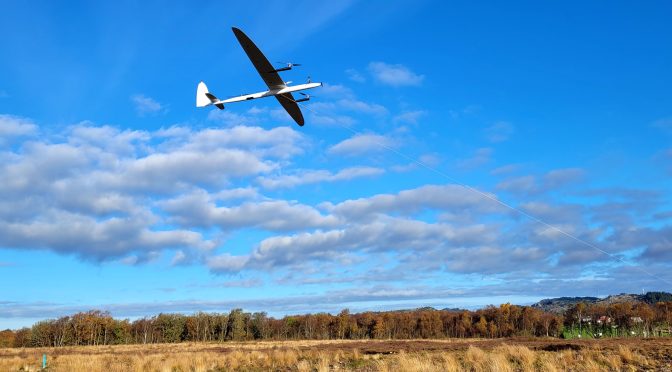
Norwegian Airborne Wind Energy developer Kitemill is preparing its technology for 24-hour continuous flights followed by multi-device demonstrations, marking a significant breakthrough for the industry.
Kitemill CEO Thomas Hårklau said rapid advances will be made in 2024 after securing more than €2million in funding from Dutch investment entity Expanding Dreams. Together with smaller investors and a tax relief grant, the combined multi-million-euro package covers the majority of planned activity for the year.
“We have a permit to set up five systems, plus equipment to set up two,” said Mr Hårklau. “The next big milestone is five hours of continuous operation, five times a week – showing we are flying with confidence, and not an ad-hoc operation. After a solid period of demonstration under these conditions, we will move to the 24-hour milestone. This will occupy the team for some time.
“Thoughout 2024 Kitemill will be focusing on fault handling in order to demonstrate we can automatically mitigate faults and safely land the system,” added Mr Hårklau. “It will be very important for us to turn our back to the systems so we can put several system together to demonstrate simultaneous operation. Before the New Year, Kitemill introduced new functionality which was a necessary step in order to start delivering on these milestones.”
In May 2023, Kitemill extended its flight endurance record clocking five hours of continuous operation for the first time. The breakthrough coincided with another landmark as the firm surpassed 500 test flights through the KM0 and KM1 pilot systems.
Later in the year, Kitemill unveiled plans for its first commercial scale system, KM2. The ground-breaking technology is set to feature in the €7.5m Norse Airborne Wind Energy Project (NAWEP), backed by the EU Innovation Fund, with a total of 12 KM2 units due for installation.
Just days ago, Kitemill visited Brussels for an event hosted by the European Climate, Infrastructure and Environment Executive Agency (CINEA). Discussions centred around the EU’s updated goals for renewable energy, emphasizing a collective commitment to a sustainable future, including the EU Innovation Fund’s role supporting ground-breaking technologies such as AWE.
Kitemill CEO Thomas Hårklau said efforts by developers on the continent are being greatly supported by advocacy and leadership from Airborne Wind Europe. However, he said the sector still remains under-invested compared to other emerging technologies which will have far less impact if they succeed and a far higher threshold to become viable.
“2024 will be a pivotal year for Kitemill as we refine our technology and position ourselves firmly at the forefront of the Airborne Wind Energy industry,” he said. “By late 2024, early 2025, we aim to start simultaneous operation. AWE technology targets large untapped wind resources up to a half-mile above ground, where stronger and more consistent winds can be harnessed with lower carbon intensity, compared with other renewables – generating greater energy yields at lower cost.”
Kitemill’s KM1 pilot system consists of a kite, tether and ground station. During production phase, the kite flies downwind in a circle building up lifting force by pulling on a tether, which is reeled around a winch at ground level and linked to an electric machine. The automatic system constantly seeks optimal altitude and wind speed.
Established in 2008, the Norwegian firm has spent more than a decade building world-class knowledge, IP and assets, with acquisitions including Scotland’s Kite Power Systems (KPS) and Dutch firm eKite, plus significant investments from En-Vision Europe Limited Ignatia and the European Innovation Council.
A white paper conducted by BVG Associates, on behalf of Airborne Wind Europe, projects the AWE market to reach around $100bn (€92.39bn) by 2035–40 and several hundreds of billions soon after. Based on the assumption that AWE follows the same trend as the established wind turbine market 40 years ago, BVG further estimates the cumulative global deployment of AWE could reach 5GW by 2035 and at least 177GW by 2050.
Research indicates that harvestable high-altitude wind power is around 4.5 times stronger than ground level resources. AWE also allows for continuous adjustment of harvesting altitude seeking the best available wind resource. This high-capacity factor ensures a more consistent and stable energy supply alleviating intermittency issues experienced by more established renewables, and supporting future hybrid energy models.In addition, AWE substantially reduces material consumption by up to 90%, for example replacing wind turbine towers with lightweight tethers. This has a hugely positive impact on overall costs, manufacturing, transport and logistics operations, as well as carbon footprints and environmental impact.Another strong benefit is the versatility of AWE technology. Being scalable from a few kilowatt to several megawatt, the systems are suitable for a broad range of markets including offshore repowering, floating offshore, mountainous and remote locations.The first commercial AWE systems are already competitive in markets with diesel-based power generation, with experts estimating AWE will reach parity with established onshore wind by the mid 2030s.